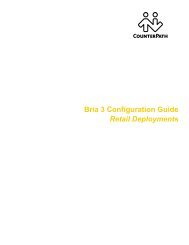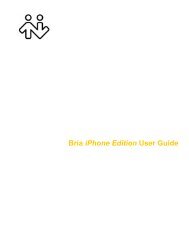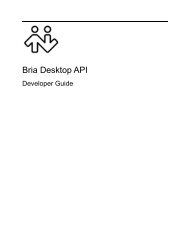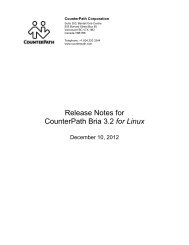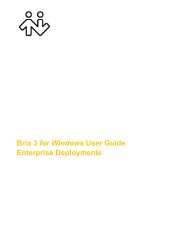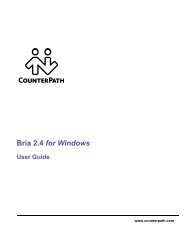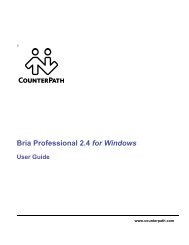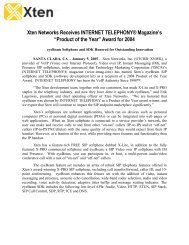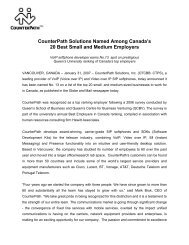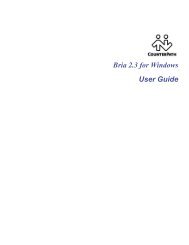Bria 3 Administrator Guide - CounterPath
Bria 3 Administrator Guide - CounterPath
Bria 3 Administrator Guide - CounterPath
Create successful ePaper yourself
Turn your PDF publications into a flip-book with our unique Google optimized e-Paper software.
<strong>CounterPath</strong> Corporation<br />
4.5 Preferences – Directory<br />
If your organization has an LDAP or Active Directory server, you can configure <strong>Bria</strong> to connect to that server.<br />
The entries from the directory will appear in the Directory tab (alongside the Contacts and History tabs).<br />
If your users use both <strong>Bria</strong> for Windows and <strong>Bria</strong> for Mac, you can deploy a directory using LDAP. If your users<br />
use only <strong>Bria</strong> for Windows, you can deploy a directory using LDAP or Active Directory.<br />
In Directory Type, select the desired option. Other fields appears; see below.<br />
LDAP<br />
LDAP Settings<br />
Field<br />
Description<br />
Server Settings<br />
Server<br />
Authentication method<br />
Username<br />
Credential<br />
Root DN<br />
Search expression<br />
The hostname or IP address of the directory server. For example, ldap.example.com.<br />
Anonymous or Simple.<br />
Choose Simple if your LDAP server requires a valid login in order to allow binding and searching<br />
the directory.<br />
The full DN of the username that will be used for authenticating to the directory.<br />
For example:<br />
CN=ldapauthuser,OU=users,OU=company,DC=example,DC=com<br />
Leave blank if Authentication is set to Anonymous.<br />
The password for the username. Leave blank if Authentication is Anonymous.<br />
The “base” DN of the server where searches will begin. The entire subtree under the Root DN will<br />
be used for searching. For example:<br />
OU=users, OU=company, DC=example,DC=com<br />
The query used to filter valid users in the directory. This query can be used to retrieve only<br />
members of a group, for example. For example:<br />
(memberOf=CN=Corporate Users, Ou=Groups, OU=company, DC=example,DC=com)<br />
46



